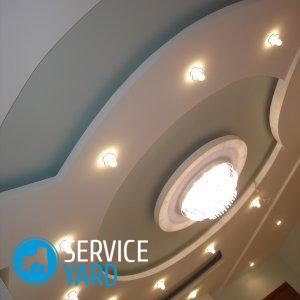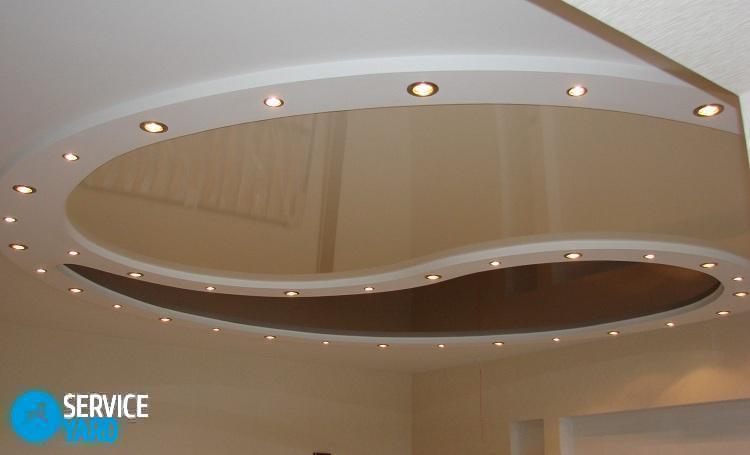Installation of spotlights in drywall

According to many experts, spotlights built into a drywall construction are the best option for lighting rooms with suspended ceilings. Evenly distributed on the surface, such lamps provide good lighting in both small and spacious rooms. Installing spotlights in drywall is not too complicated, but it has a number of features that cannot be neglected. This article is a detailed installation guide for spot lighting.
to contents ↑Design Features
A spotlight is a small-sized lighting fixture that, after installation, forms a single plane with the surface of a suspended or suspended ceiling. Due to the small size in the room, several lighting devices need to be mounted, distributing them over the entire area.
to contents ↑Embedded Sources
Installation of fixtures in a plasterboard ceiling is carried out using special spring mounts. The spring is inserted into the prepared hole, it is straightened, and the lighting device is firmly pressed to the ceiling lining.
The outer part of the lamp is equipped with a decorative trim. Its purpose is to mask the gap between the edges of the prepared hole and the lamp.
to contents ↑Important! Lining design may vary. Depending on the style of the room, you can choose several varieties of overlays.
Location of light sources
The optimal parameters for the placement of spotlights are as follows:
- The interval between the wall and the lamp is up to 600 mm.
- The interval between the rows of recessed luminaires is up to 1000 mm.
- The distance between the devices in a row is up to 1500 mm.
to contents ↑Important! The most effective is the placement of electric lamps in a checkerboard pattern. Lighting will be more even. The placement of additional lamps on various interior details looks good. A point source cornice is great for lighting your desktop.
Which spotlights are better to choose from a plasterboard ceiling?
The choice of specific electric luminaires mounted in drywall depends on many factors. Consider the most common types of them according to different classification criteria, which will allow you to make a choice.
According to the structure, rotary and non-rotary structures are distinguished:
- The device of a fixed spot lamp is extremely simple. The light from it has a certain direction. You cannot redirect the light flux.
- The pivot lamp has a slightly more complex device. Installation of built-in fixtures in drywall is somewhat more time-consuming. The advantage of this option is that it is possible to redirect the light flux as needed.
By the type of light source, the following categories of light bulbs are distinguished:
- Halogen.
- LED light.
- Luminescent.
- Light bulbs.
Not only the type of lighting and energy consumption, but also the parameters of the lamp itself depend on what type of light source is used.For example, incandescent lamps are the most bulky, therefore they are suitable only for spacious rooms. Luminescent or LED devices are much more compact, the size of spotlights for installation is much smaller. But their cost in comparison with incandescent lamps is higher.
Important! In order for the room lighting to create the effect of warmth and comfort, as well as to reduce the heating of the electric bulbs, it is advisable to choose devices with a mirror coating.
Of course, the above classification is the most general and enlarged, therefore, before choosing spotlights for gypsum plasterboard ceilings, you will have to study the range of products and only then decide on the final decision.
to contents ↑Preparatory work
So, you have purchased lighting devices, it's time to start installing them. The best option for self-repair is the parallel execution of works on the formation of the ceiling structure and the installation of lamps. Thus, you have the opportunity to optimize the location of the fixtures and mount the wiring before sheathing the frame with plasterboard.
First stage:
- Mark the location of the light bulbs in advance on the ceiling.
- Place the electric lamps so that the minimum distance from the metal elements of the frame is 250-300 mm.
- Plan your lighting for different levels of suspended ceiling. At the same time, each level has its own lighting circuit.
Important! When planning the placement of point devices, be sure to consider the presence of other lamps: sconces, pendant and ceiling devices. For example, if a large chandelier is placed in the center of the ceiling, then the point sources of light around the room’s perimeter serve as an additional source of lighting.
Manufacture of electrical wiring
At the stage of forming the metal frame, wiring must be laid in order to connect the built-in lighting.
Important! To simplify the work, make a scale drawing showing all the lighting elements - lamps, wires, transformers, switches.
If you plan to install electric lamps on the wall, then for them you need to perform a separate wiring. The choice of wires is carried out according to the following principles:
- The most reliable for connecting to lamps is a stranded soft wire.
- If we talk about the reliability of the system as a whole, then the best option is hard or soft wires. This option is more preferable when used for connecting terminal blocks.
to contents ↑Important! Lay wires in special pipes made of corrugated plastic. They protect the wiring from water in the event of accidental leaks from above and from mechanical damage. It is possible to fix plastic pipes on a metal frame with hose clamps made of plastic.
Lighting holes
Before the final installation of spot lighting, you need to make holes in the drywall. Typically, the diameter of the hole is indicated on the package of the spotlight.
Here are the basic principles for hole milling:
- The most common diameters of holes in drywall for mounting fixtures are 60 and 75 mm. To drill holes, a drill with a cutter-nozzle for drywall is used.
- It is advisable to make mounting holes even before the ceiling cover sheets are fixed. The probability of error with this approach is the smallest. If you have to make holes in already mounted sheets, use the layout of the bulbs on the ceiling surface.
- To avoid a milling cutter colliding with a metal profile on the ceiling, hold a magnet to the drywall sheet before drilling holes.
- Mount the electric bulbs themselves in drywall after finishing work is completed. To do this, remove the previously laid wires in the prepared holes.
The procedure for connecting to the terminal block is as follows:
- Secure the wires from the spotlight socket holder to the terminal block.
- Fasten the wires from the mains laid under the ceiling on the other side.
Important! Do not forget to pay attention to the markings on the lamp: N - zero, PE - grounding, L - phase.
- After that, install the electric lamp in the hole. If the lamp is inserted into the lampholder, install a decorative trim. It remains only to test the system for performance.
Stock footage
In the presence of a certain skill and knowledge of electrical engineering, it is quite simple to install built-in LED lamps in the ceiling of drywall. A little time, patience, and the ceiling with built-in lighting is ready!
- How to choose a vacuum cleaner taking into account the characteristics of the house and coatings?
- What to look for when choosing a water delivery
- How to quickly create comfort at home - tips for housewives
- How to choose the perfect TV - useful tips
- What to look for when choosing blinds
- What should be running shoes?
- What useful things can you buy in a hardware store
- Iphone 11 pro max review
- Than iPhone is better than Android smartphones




